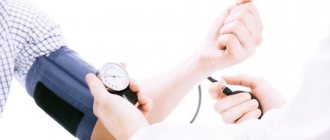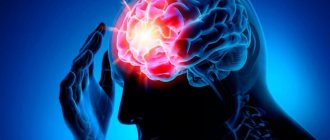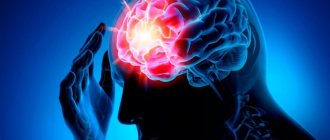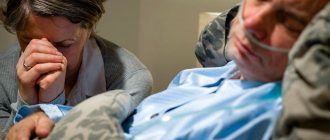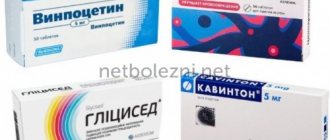What is a stroke, its types
A stroke is a disorder of cerebral circulation leading to brain damage.
The pathology is widespread. In the Russian Federation alone, there are 3 cases of stroke per 1000 inhabitants. In the post-mortem extract, it is listed as the cause of death in 23.5% of people.
Even if patients do not die after suffering a vascular accident, more than 80% of them remain disabled. Often neurological disorders are so severe that the patient is unable to care for himself. Stroke is the third leading cause of death.
There are 2 types of stroke: ischemic and hemorrhagic. The mechanism of their development and the features of treatment have nothing to do with each other. There is also a special type of hemorrhagic vascular damage - subarachnoid hemorrhage.
Ischemic
Ischemic stroke is a cerebral circulatory disorder accompanied by an acute onset. Pathology develops due to disruption or complete cessation of blood supply to the brain. This leads to softening of its tissues and infarction of the affected area. It is cerebral vascular ischemia that is one of the main causes of death worldwide. Such a stroke occurs 6 times more often than hemorrhagic lesions.
It can be of 2 types:
- Thrombotic . Develops due to blockage of blood vessels in the brain by a blood clot.
- Embolic . Occurs when blood vessels located far from the brain become blocked. The most common source of embolism is the heart muscle (cardioembolic stroke).
In 80% of cases, the pathological focus is localized in the middle cerebral artery. Other vessels account for the remaining 20%.
Reasons that can provoke ischemic damage to cerebral arteries and veins:
- Myocardial infarction.
- High or low blood pressure.
- Atrial fibrillation.
- Diabetes.
- Lipid metabolism disorders.
Risk factors include: old age, hereditary predisposition to vascular accidents, as well as lifestyle features.
Symptoms of ischemic stroke do not increase as quickly as symptoms of hemorrhagic brain damage.
Its manifestations:
- Drowsiness, dazedness.
- Brief fainting.
- Headache, dizziness.
- Nausea and vomiting.
- Pain in the eyes that gets worse with movement.
- Cramps.
- Sweating, hot flashes, dry mouth.
Depending on which part of the brain is affected, the neurological manifestations of ischemia differ. The lower and upper extremities are affected to a greater or lesser extent, paresis of the tongue and face is observed, and visual and/or auditory function deteriorates.
Hemorrhagic
Hemorrhagic stroke is bleeding into the cranial cavity. The most common cause of blood vessel rupture is high blood pressure.
Other provoking factors include:
- Aneurysm.
- Malformation of cerebral vessels.
- Vasculitis.
- Systemic connective tissue diseases.
- Taking certain medications.
- Amyloid angiopathy.
The onset of the pathology is acute; most often the manifestation occurs against the background of high blood pressure. A person experiences severe headaches, dizziness, accompanied by vomiting or nausea. This state is quickly replaced by stupor, loss of consciousness, and even the development of coma. Convulsions are possible.
Neurological symptoms manifest themselves in the form of memory loss, deterioration of sensitivity and speech function. One side of the body, which is on the opposite side of the lesion, loses the ability to function normally. This applies not only to the muscles of the torso, but also to the face.
A stroke with blood escaping into the ventricles of the brain is difficult to endure. The victim develops symptoms of meningitis and has seizures. He quickly loses consciousness.
The next 3 weeks after a stroke are considered the most difficult. At this time, cerebral edema progresses. It is he who is the main cause of death of patients. Starting from the fourth week, in surviving people, the symptoms of the lesion begin to reverse. From this time on, the severity of brain damage can be assessed. They are used to determine what degree of disability to assign to the victim.
Subarachnoid hemorrhage
Subarachnoid hemorrhage is understood as a condition that develops as a result of a breakthrough of blood vessels into the subarachnoid space of the brain. This pathology is a type of hemorrhagic stroke.
The subarachnoid space contains cerebrospinal fluid, the volume of which increases due to blood flow. The patient's intracranial pressure increases and meningitis of aseptic nature develops. The situation is aggravated by the reaction of cerebral vessels. They spasm, which leads to ischemia of the affected areas. The patient develops an ischemic stroke or transient ischemic attack.
The following reasons lead to hemorrhage into the subarachnoid space::
- Traumatic brain injuries with damage to the integrity of blood vessels.
- Aneurysm rupture.
- Dissection of the carotid or vertebral artery.
- Myxoma of the heart.
- A brain tumor.
- Amyloidosis.
- Diseases associated with blood clotting disorders.
- Uncontrolled use of anticoagulants.
The pathology manifests itself as a severe headache. Possible loss of consciousness. In parallel, symptoms of meningitis develop, with neck stiffness, vomiting, and photophobia. A distinctive sign is an increase in body temperature. In severe cases, there is a disorder of respiratory function and cardiac activity. With prolonged fainting and coma, one may suspect that blood has entered the ventricles of the brain. This occurs during its massive outpouring and threatens with serious consequences.
What is a stroke?
Acute cerebrovascular accident (ACVA) was previously called apoplexy, which translated from Greek means “paralysis.” The disease is classified as a severe cerebrovascular pathology, accompanied by high mortality. 70-80% of patients who have had a stroke become disabled.
The clinical picture is represented by focal and cerebral neurological symptoms. The first signs of the disease are:
- weakness, possible fainting;
- sudden agitation or drowsiness at the initial stage;
- Strong headache;
- nausea, vomiting;
- speech disorder;
- facial paresis;
- dizziness, loss of orientation in space and time;
- sweating, increased heart rate, dry mouth and other autonomic disorders.
Against the background of the development of cerebral symptoms, focal neurological phenomena occur, the nature of which depends on the location of the damaged vessel. If the blood supply to the occipital zone and the cerebellum is impaired, increasing muscle weakness of the upper and lower extremities, unsteadiness of gait, and paresthesia of the arms and legs are observed.
The focus of ischemia and necrosis of the brain (shown by arrows) on MRI
Damage to the vertebrobasilar circle leads to dizziness, loss of balance, and possible vomiting. Vision deteriorates, the eye muscles on the affected side suffer, and the sensitivity of half the body decreases.
The patient cannot repeat a simple phrase and does not answer questions. When trying to smile, one corner of the mouth remains lowered, and the tip of the tongue moves towards the affected side.
Depending on the pathogenesis of the disease, there are four main types of stroke:
- ischemic;
- hemorrhagic;
- subarachnoid hemorrhage;
- acute hypertensive encephalopathy.
Pathologies of the great vessels play a significant role in the development of ischemic stroke. Cerebral infarction occurs when there is stenosis or thrombosis of the brachiocephalic and intracranial (intracranial) arteries. Lack of oxygen and nutrients causes necrosis of cerebral cells, which leads to the development of neurological disorders. The causes of severe hypoxia are atherosclerosis, embolism, and a sharp decrease in blood pressure (BP). In the diagnosis of ischemic stroke, MRI, CT of the brain, and other instrumental research methods are used. The prognosis largely depends on the ability to differentiate the disease in the early stages.
Hemorrhagic stroke occurs when intracerebral hemorrhage leads to the death of nerve cells. The disease develops against the background of hypertension, causing spasms and paralysis of the intracranial arteries. The walls of blood vessels become permeable to plasma and formed elements, lose their tone and passively expand with increasing blood pressure.
Picture of the development of ischemic stroke on MRI (T1- and T2-weighted images)
Subarachnoid hemorrhage occurs when an aneurysm ruptures, arteriovenous malformations, malignant diseases, or due to traumatic brain injury. Neurological symptoms appear when the cerebral substance is compressed due to the formation of hematomas in the area of the soft arachnoid membrane.
Acute hypertensive encephalopathy develops against the background of persistent arterial hypertension. A prolonged increase in blood pressure leads to progressive damage to brain tissue. In case of ineffective treatment, hypertensive encephalopathy ends in ischemic or hemorrhagic stroke, swelling of cerebral structures, and death is possible. The danger of the condition lies in the absence of a clear clinical picture.
MRI diagnostics allows for timely detection of stroke and prescribing effective treatment. The volume and nature of medical care depend on the stage of the disease. The following periods of development of the pathological process are distinguished:
- elementary;
- spicy;
- early recovery;
- late rehabilitation;
- period of long-term consequences.
Recovery time depends on the location and size of the necrosis focus, the patient’s age, the effectiveness of treatment procedures and other factors.
Signs and symptoms of stroke
A stroke manifests unexpectedly for a person, although sometimes it is preceded by certain symptoms. If you interpret them correctly, you can avoid a terrible vascular catastrophe.
Warning signs of an impending stroke include:
- Prolonged headaches. They do not have a clear localization. It is not possible to cope with them with the help of analgesics.
- Dizziness. It occurs at rest and can intensify when performing any actions.
- Ringing in the ears.
- Sudden attack of atrial fibrillation.
- Difficulty swallowing food.
- Memory impairment.
- Numbness of arms and legs.
- Loss of coordination.
- Insomnia.
- Increased fatigue.
- Decreased overall performance.
- Rapid heartbeat and constant thirst.
The listed signs may have varying intensities. You should not ignore them; you should consult a doctor.
Symptoms of ischemic stroke increase slowly. With hemorrhagic brain damage, the clinical picture unfolds rapidly.
You can suspect a brain catastrophe based on the following symptoms::
- General cerebral symptoms . The patient experiences unbearable headaches. Nausea ends with vomiting. Consciousness is impaired, and both stupefaction and coma may occur.
- Focal symptoms . They directly depend on where exactly the lesion is localized. The patient may have decreased or completely lost muscle strength on one side of the body. Half of the face is paralyzed, causing it to become distorted. The corner of the mouth lowers, the nasolabial fold smoothes out. On the same side, the sensitivity of the arms and legs decreases. The victim’s speech deteriorates and he has difficulty oriented in space.
- Epileptiform symptoms . Sometimes a stroke provokes an epileptic attack. The patient loses consciousness, has convulsions, and foam appears at the mouth. The pupil does not react to the light beam; on the side of the lesion it is dilated. The eyes move right and left.
- Other symptoms . The patient's breathing quickens and the depth of inspiration decreases. A significant decrease in blood pressure and increased heart rate are possible. Often a stroke is accompanied by uncontrolled urination and defecation.
When the first signs of a stroke appear, you should not hesitate to call an ambulance.
People after a stroke
If a person has had a stroke, it is not difficult to determine a preliminary diagnosis. People after a stroke (photo 2) have characteristic signs, based on the totality of which it is possible to say with a high probability whether there is a cerebral hemorrhage or not. Hypertension complicates a stroke if it is diagnosed in the patient. Doctors identify the following signs of the disease:
- The appearance of a crooked smile - if you ask a victim after a stroke to smile, then his smile during a stroke will not be like that of a healthy person, so you can suspect something is wrong. The face after a stroke (photo below) looks pained, the corners of the lips become asymmetrical, one goes down and the other goes up.
- The speech of victims who have suffered an attack also has characteristic signs - people with strokes manifest themselves in slow pronunciation. Outwardly, a person looks like a drunk; he may confuse words or even stutter.
- When asked to raise their arms, stroke patients usually cannot do this synchronously, and one arm will be lower than the other.
- If you ask a person to stick out his tongue, you will notice that it becomes skewed and weakly sticks to one side.
A stroke in people provokes all these signs, some are just more pronounced, and some less. If you provide assistance in the first three hours after an attack, then in this case it is possible to avoid most of the complications that arise after an acute cerebrovascular accident.
Diagnostic methods
It is important to quickly distinguish a stroke from other diseases that can lead to the development of similar symptoms. It is almost impossible to do this on your own, as well as to determine the type of vascular accident.
The main difference between an ischemic stroke is a gradual increase in symptoms that do not lead to loss of consciousness. With hemorrhagic hemorrhage, the patient passes out quickly. However, stroke does not always have a classic course. The disease may begin and progress atypically.
Diagnosis begins with examination of the patient. The doctor collects anamnesis and determines the presence of chronic diseases. Most often, you can get information not from the victim himself, but from his relatives. The doctor performs an ECG, determines the heart rate, takes a blood test, and measures blood pressure.
It is possible to make the correct diagnosis and obtain maximum information about the patient’s condition thanks to instrumental diagnostic methods. The best option is a CT scan of the brain. Performing an MRI is difficult because the procedure takes a long time. It takes about an hour. It is impossible to spend this amount of time diagnosing an acute stroke.
Computed tomography allows you to clarify the type of pathology, where it is concentrated, to understand how badly the brain is damaged, whether the ventricles are affected, etc. The main problem is that it is not always possible to perform a CT scan in the shortest possible time. In this case, doctors have to focus on the symptoms of the disease.
To determine the source of the stroke, the method of diffusion-weighted tomography (DWI) is used. The information will be received within a few minutes.
Other examination methods include:
- Lumbar puncture.
- Cerebral angiography.
- Magnetic resonance angiography. It is performed without the introduction of a contrast agent.
- Doppler ultrasound.
Once the diagnosis is made, the doctor will immediately begin treatment.
Ischemic cerebral stroke
Ischemic stroke is the most common form of acute cerebrovascular accident.
Pathology
Cerebral infarction is a zone of necrosis formed as a result of persistent disturbances of cerebral circulation due to stenosis (occlusion), embolism or thrombosis of the main arteries in the neck or brain.
Microscopically
- 12-24 hours: eosinophilic granules in the cytoplasm of neurons, pycnolysis of the nucleus, disappearance of the Nissl substance (body)
- 24-72 hours: neutrophil infiltration
- 3-7 days: infiltration by macrophages and glial cells, beginning of phagocytosis
- 1-2 weeks: reactive gliosis and proliferation of small vessels at the border of the necrosis zone
- more than 2 weeks: formation of a glial scar
Subtypes of ischemic stroke
TOAST and Baltimore-Washington Cooperative Young Stroke Study criteria 1993-1995
- atherothrombotic 14-66%
- cardioembolic 20%
- lacunar (small artery occlusion) 10-29%
- acute stroke with another specific etiology 6-16%
- stroke of unknown etiology 1-8 - 29-40%
Stages by RG Gonzalez
- acute
- up to 6 hours
- interventions are possible
- acute
- 6-24 hours
- stroke may not be visible on CT/MRI
- subacute
- 24 hours - 6 weeks
- contrast accumulation stage
- fogging effect
- chronic
- more than 6 weeks
- resorption and scarring
Diagnostics
CT scan
Early CT signs of ischemic stroke
- Obscuration of lenticular nuclei.
- Pointed increase in MCA density
- Hyperdense middle cerebral artery sign
- Decreased differentiation of the insular cortex
Late CT signs of ischemic stroke:
- zone of hypodense density of brain parenchyma
Magnetic resonance imaging
Diffusion-weighted images
Diffusion-weighted images are most sensitive to stroke. Normally, water protons diffuse extracellularly, so the signal is lost. High signal intensity on DWI indicates a limitation in the ability of water protons to diffuse extracellularly. As a result of cytotoxic edema, an imbalance of extracellular water to Brownian motion occurs, so these changes are clearly detected on DWI. ADC maps may demonstrate a hypointense signal within minutes of stroke onset and are more sensitive than diffusion-weighted images. There are several reports of documented strokes accompanied by the absence of changes on DWI in the first 24 hours, particularly in the vertebrobasilar region. in the trunk and in the case of lacunar infarctions [1].
T2-weighted images
High signal intensity on T2-weighted images does not appear in the first 8 hours after the onset of ischemic stroke. Hyperintensity is characteristic of the chronic phase, reaching a maximum in the subacute period. The haze phenomenon on MRI can be visualized 1–4 weeks after stroke, with a peak occurring at 2–3 weeks, and appears as an isointense area relative to the GM, which is thought to be a consequence of infiltration of the infarct area by inflammatory cells. In large lesions, there may be loss of normal ipsilateral carotid flow on T2-weighted images 2 hours after symptom onset.
FLAIR images
Signal intensity on FLAIR images after stroke varies. Most studies show that signal intensity on FLAIR images changes in the first 6 to 12 hours after symptom onset. The simultaneous presence of changes on DWI and the absence of such changes on FLAIR images indicates a stroke less than 3 (6) hours old with specificity (93%) and positive predictive value (94%) [1].
T1-weighted images
Low signal intensity in the affected area is usually not visible in the first 16 hours after the onset of symptoms, but persists in the chronic phase. The presence of an area of serpinginous cortical hyperintensity may be present in patients with laminar or pseudolaminar necrosis 3 to 5 days after onset, but is most often visualized after 2 weeks.
Signal characteristics depending on the stage [1]:
Early acute stroke (0-6 hours)
- T1 : isointense signal
- T1 with paramagnetic agents : arterial accumulation of contrast agent may occur in the first two hours;
- parenchymal contrast accumulation in an incomplete stroke may occur for 2-4 hours
- isointense signal;
- signal intensity varies;
Late acute period (6-24 hours)
- T1 : usually low signal intensity approximately 16 hours after onset
- T1 with paramagnetic agents : arterial accumulation of contrast material may occur;
- cortical enhancement in incomplete stroke;
- possible meningeal accumulation
Acute and early subacute period (24 hours-1 week)
- T1 : low signal intensity;
- hyperintensity with cortical necrosis (3-5 days)
- arterial and meningeal storage patterns;
Subacute period (1-3 weeks)
- T1 : low signal intensity;
- hyperintensity with cortical necrosis (after 2 weeks)
- high signal intensity on days 10-14;
- low signal intensity on days 7-10;
Chronic period (>3 weeks)
- T1 : low signal intensity;
- may hyperintensity with cortical necrosis (after 2 weeks)
- signal intensity varies;
Differential diagnosis
- CT states simulating cerebral artery hyperdensity high hematocrit
- microcalcifications in the vascular wall
- low density of brain parenchyma (e.g. due to edema), due to which the vessels appear more hyperdense
- infiltrating tumor (eg astrocytoma)
Who is at risk
There are people who need to be especially wary of developing a stroke, as they are at risk.
Among them:
- Persons with hypertension.
- Patients with diabetes.
- Men and women over 65 years of age.
- People with abdominal obesity.
- Persons with a hereditary predisposition to vascular pathologies.
- Patients who have previously had a stroke or heart attack.
- Patients with diagnosed atherosclerosis.
- Women over 35 years of age taking oral contraceptives.
- Smokers.
- People suffering from heart rhythm disturbances.
- People with high cholesterol levels.
Most often, patients with the listed diagnoses are registered at the dispensary. Special mention should be made of people living in a state of chronic stress. Emotional stress negatively affects all systems of the body and can cause a stroke.
How to provide first aid for a stroke
There is a clear algorithm for providing first aid to a person suffering from a stroke :
- Call a medical team . To do this, you need to dial 103 from a landline phone. If you happen to have a smartphone at hand, then the call is made to the single number 112. The doctor must immediately be informed that the person is unwell and there is a suspicion of a stroke.
- The victim must be laid on a flat surface so that his head is higher than his body. They take off his glasses and remove his lenses. If possible, you need to help him get removable dentures.
- If there is no consciousness, then you need to open the patient’s mouth slightly and turn his head to the side . This is done to prevent aspiration of vomit. It is imperative to listen to the patient’s breathing.
- For better access to fresh air, it is recommended to open a window or vent..
- Before the arrival of the medical team, it is necessary to prepare documents, if any..
Doctors need to be informed about the person’s illnesses, as well as what medications he is taking. It is prohibited to give the victim any medications. Medication correction should be carried out by emergency physicians. You should not try to give water or food to a person. This may make the situation worse.
If the patient falls and has an epileptic attack, there is no need to unclench his teeth or try to hold him. It is necessary to protect the victim from injury. To do this, place a soft object, such as a pillow, under his head. If a stroke with an epileptic attack happened on the street, then you can use a jacket or other suitable thing. Foam flowing from the mouth is wiped away with a cloth. The head should be elevated at all times.
There is no need to try to bring a person to his senses with ammonia. Until the end of the attack, it should not be moved from place to place.
If breathing stops, resuscitation measures must be started immediately. To do this, perform a heart massage and breathe mouth to mouth or mouth to nose.
What does a stroke look like in people?
A stroke in people looks like a loss of consciousness, a pre-fainting state, but the disorders in the brain are more serious than with normal fainting. Symptoms of a stroke do not appear suddenly - usually a person feels characteristic signs of deteriorating health, but few people know that a deterioration in health will be followed by the development of a stroke.
The first signs of a stroke appear in the form of sudden weakness, dizziness, sharp pain in the head, and visual disturbances. Following these symptoms, in stroke victims, the pulse slows down, blood rushes to the face, cold sweat appears on the forehead, speech or motor activity is impaired, like a myocardial infarction, a stroke can provoke numbness of the limbs or part of the body.
Sometimes the brain is affected by a microstroke (photo in gal.) - it is also called transient ischemic attacks. Signs of a micro-stroke may not be so noticeable, so patients complain only of minor deterioration in health - dizziness, spots in the eyes, weakness, pre-syncope, which does not always end in fainting. A facial stroke develops in the form of muscle paresis of one side.
Treatment and rehabilitation
The patient receives treatment in a hospital. All patients with suspected stroke are hospitalized on an emergency basis. The optimal period for providing medical care is the first 3 hours after a brain accident has occurred. The person is placed in the intensive care unit of a neurological hospital. After the acute period has been overcome, he is transferred to the early rehabilitation unit.
Until the diagnosis is established, basic therapy is carried out. The patient’s blood pressure is adjusted, the heart rate is normalized, and the required blood pH level is maintained. To reduce cerebral edema, diuretics and corticosteroids are prescribed. Craniotomy is possible to reduce the degree of compression. If necessary, the patient is connected to an artificial respiration apparatus.
Be sure to direct efforts to eliminate the symptoms of stroke and alleviate the patient’s condition. He is prescribed medications to lower body temperature, anticonvulsants, and antiemetics. Medicines that have a neuroprotective effect are used.
Pathogenetic therapy is based on the type of stroke. In case of ischemic brain damage, it is necessary to restore nutrition to the affected area as quickly as possible. To do this, the patient is prescribed drugs that resolve blood clots. It is possible to remove them mechanically. When thrombolysis fails, the patient is prescribed Acetylsalicylic acid and vasoactive drugs.
In case of a stroke, it is extremely important to provide timely treatment to the damaged areas of the brain. A course of use of the drug accelerates the process of recovery of brain cells after a stroke, even in cases of impaired blood circulation or hypoxia. This allows for rapid restoration of memory, thinking, speech, swallowing reflex and restoration of other functions of daily activities. Gliatilin has a positive effect on the transmission of nerve impulses, protects brain cells from repeated damage, which prevents the risk of recurrent stroke.
The drug is well tolerated by patients; it is contraindicated for use by pregnant, lactating women and people with hypersensitivity to choline alfoscerate.
Courses will need to be taken regularly. You definitely need to do physical therapy, undergo physical therapy, and visit a massage therapist. After a stroke, many patients have to restore motor skills over a long period of time and learn to care for themselves independently.
Relatives and friends should provide support to the patient and not leave him alone with the problem. Psychologists are involved in the work. Sessions with a speech therapist are often required.
Brain after stroke
A brain stroke (see photo 3) provokes pathological changes that occur due to vascular problems, for example, arterial thrombosis, which abruptly stops the access of oxygen to brain cells. 20% of the oxygen entering the body goes to ensure an active brain - all the processes occurring in the brain are so costly.
As a result of a disruption in the supply of oxygen to neurons, vital cellular processes are disrupted and they become unable to carry out their conduction function. Five minutes of ischemia is enough for the brain after a stroke to lead to irreversible changes in local areas. Even a micro-stroke does not go away without leaving a trace, although the severity of complications is certainly much less.
A brain stroke provokes disruption of basic processes - speech, motor activity, and thinking. Brain cells responsible for certain processes gradually lose their functions, and after some time necrosis occurs - cell death. Depending on how many cells are affected, the severity of the stroke manifests itself. The location of the lesion gives visual manifestations of pathology.
What does a hemorrhagic stroke look like?
Hemorrhagic stroke (see photo 4) occurs when a patient has a cerebral hemorrhage due to vascular problems. Brain disorders provoke atherosclerosis, thrombosis and other pathologies of cerebral vessels. In parallel with hemorrhage, cerebral edema develops, aggravating the pathology.
Between 50 and 80% of such strokes are fatal. Determining a hemorrhagic stroke on an MRI is very simple - the area of hemorrhage and swelling will become visible as a result of the scan.
It is noteworthy that hemorrhagic stroke is much less likely to provide warning signs of disorders. People may not feel sick at all, but threatening symptoms increase in a matter of seconds. The headache of a hemorrhagic stroke is much stronger. Rarely, there may be an ocular stroke - with intracerebral hemorrhage, damage to the small vessels of the eyes is noticeable.
How does ischemic stroke manifest?
Ischemic stroke (see photo 5), as a rule, has a short period of manifestation of pathological symptoms. With this type of brain damage, the symptoms increase slowly, there is practically no headache, and if there is any, it is weak and aching. Against the background of such signs, pressure almost never increases, as happens with a hemorrhagic stroke.
After a stroke, patients may experience vomiting and involuntary urination. The first signs of a stroke in a woman are usually more difficult to bear than in a man and can be triggered by pregnancy, hormonal surges, and women’s lower resistance to stress. Ischemic stroke of the brain can cause disability, but patients remain alive.
Possible consequences, complications
The main danger of a stroke is death. If a person survives, the disease will still make itself felt with certain complications.
Early consequences include:
- Brain swelling.
- Coma.
- Pneumonia.
- Paralysis. It can be partial or complete. Most often, one half of the body is affected.
- Repeated stroke.
- Bedsores.
- Mental disorders. They can manifest themselves in moodiness, irritability, aggression, and anxiety. Sometimes dementia develops.
- Sleep disorders.
- Myocardial infarction, gastric ulcer. These disorders develop against the background of increased levels of stress hormones.
After an ischemic stroke, death occurs in 15-25% of cases. Hemorrhagic damage to the blood vessels of the brain leads to the death of 50-60% of patients. The cause of death is precisely severe complications, for example, pneumonia or acute heart failure. The first 3 months after a stroke are considered the most dangerous.
Arms recover worse in patients than legs. A person's future health is determined by the severity of brain damage, the speed of medical care, his age and the presence of chronic diseases.
Long-term consequences include:
- Formation of blood clots in various parts of the body.
- Depression.
- Speech problems.
- Memory loss.
- Deterioration of intellectual abilities.
After a stroke, you have to deal with the consequences for many months. Sometimes a person never manages to fully recover. For rehabilitation to be as successful as possible, you must strictly follow all the doctor’s instructions.
Stroke is a serious pathology because it affects the brain. Therefore, even the slightest suspicion of a developing vascular accident is a reason to urgently seek medical help.
Stroke on MRI
Stroke in medicine is an acute disturbance of blood circulation in the brain, up to its complete absence in one of the areas of the brain, resulting from blockage or rupture of blood vessels in the brain.
Stroke is considered one of the most pressing modern medical and social problems, especially in our country.
Several factors contribute to this:
- high number of cases per year (about half a million people);
- high mortality rate, both in the first month from the onset of the disease and by the end of the first year (30% and 50%, respectively);
- low percentage of surviving patients who remain disabled (about 15%).
Ischemic stroke occurs when blood circulation in a certain area of the brain is completely stopped due to blockage of a vessel. Hemorrhagic stroke is a consequence of rupture of a vessel and hemorrhage in brain tissue. Also, several other circulatory disorders fall under this term.
Everyone knows that if a stroke is suspected, the patient must be taken to the hospital immediately. The sooner a diagnosis is made and treatment is prescribed, the fewer consequences a stroke will have, the greater the chance of restoration of ability to work and a return to a full life. A stroke has external manifestations that allow an accurate diagnosis, but do not allow one to determine the type of disorder, and therefore choose the most adequate therapeutic tactics. For different types of stroke, different types of tomograms give different results.
Thus, for ischemic types of stroke, MRI is the optimal method for early diagnosis, allowing with a high degree of probability (80-90%) to identify foci of bleeding around the ischemic zone already in the first hours after the onset of bleeding. In the image, a stroke appears as areas of reduced tissue density, and what is also special in this case is the signal itself, which is hyperintensified.
Subarachnoid hemorrhage (that is, bleeding into the space between the meninges rather than into the tissue) is also best diagnosed with magnetic resonance imaging with angiography or computed tomography (CT) with contrast. Both methods are informative during the first half of the day. The study will assess the volume of hemorrhage and the degree of damage to the brain.
MRI for diagnosing microstrokes
MRI also turns out to be an effective, and sometimes even the only, method for diagnosing micro-stroke - a circulatory disorder that affects smaller vessels and forms smaller foci of bleeding, which is often asymptomatic for the patient, however, it is no less dangerous than a full-fledged stroke. A mini-stroke means that sooner or later larger damage may occur in that area of the brain.
If symptoms such as a slight violation of facial symmetry, weakened visual acuity, speech disorders and confusion appear, it is necessary to undergo a tomography examination. It will allow you to identify pinpoint foci of hemorrhage and prescribe adequate therapy, which will help prevent the occurrence of more serious consequences.
Diagnostic methods
It is important to quickly distinguish a stroke from other diseases that can lead to the development of similar symptoms. It is almost impossible to do this on your own, as well as to determine the type of vascular accident.
The main difference between an ischemic stroke is a gradual increase in symptoms that do not lead to loss of consciousness. With hemorrhagic hemorrhage, the patient passes out quickly. However, stroke does not always have a classic course. The disease may begin and progress atypically.
Diagnosis begins with examination of the patient. The doctor collects anamnesis and determines the presence of chronic diseases. Most often, you can get information not from the victim himself, but from his relatives. The doctor performs an ECG, determines the heart rate, takes a blood test, and measures blood pressure.
It is possible to make the correct diagnosis and obtain maximum information about the patient’s condition thanks to instrumental diagnostic methods. The best option is a CT scan of the brain. Performing an MRI is difficult because the procedure takes a long time. It takes about an hour. It is impossible to spend this amount of time diagnosing an acute stroke.
Computed tomography allows you to clarify the type of pathology, where it is concentrated, to understand how badly the brain is damaged, whether the ventricles are affected, etc. The main problem is that it is not always possible to perform a CT scan in the shortest possible time. In this case, doctors have to focus on the symptoms of the disease.
To determine the source of the stroke, the method of diffusion-weighted tomography (DWI) is used. The information will be received within a few minutes.
Other examination methods include:
- Lumbar puncture.
- Cerebral angiography.
- Magnetic resonance angiography. It is performed without the introduction of a contrast agent.
- Doppler ultrasound.
Once the diagnosis is made, the doctor will immediately begin treatment.
Who is at risk
There are people who need to be especially wary of developing a stroke, as they are at risk.
Among them:
- Persons with hypertension.
- Patients with diabetes.
- Men and women over 65 years of age.
- People with abdominal obesity.
- Persons with a hereditary predisposition to vascular pathologies.
- Patients who have previously had a stroke or heart attack.
- Patients with diagnosed atherosclerosis.
- Women over 35 years of age taking oral contraceptives.
- Smokers.
- People suffering from heart rhythm disturbances.
- People with high cholesterol levels.
Most often, patients with the listed diagnoses are registered at the dispensary. Special mention should be made of people living in a state of chronic stress. Emotional stress negatively affects all systems of the body and can cause a stroke.
How to provide first aid for a stroke
There is a clear algorithm for providing first aid to a person suffering from a stroke :
- Call a medical team . To do this, you need to dial 103 from a landline phone. If you happen to have a smartphone at hand, then the call is made to the single number 112. The doctor must immediately be informed that the person is unwell and there is a suspicion of a stroke.
- The victim must be laid on a flat surface so that his head is higher than his body. They take off his glasses and remove his lenses. If possible, you need to help him get removable dentures.
- If there is no consciousness, then you need to open the patient’s mouth slightly and turn his head to the side . This is done to prevent aspiration of vomit. It is imperative to listen to the patient’s breathing.
- For better access to fresh air, it is recommended to open a window or vent..
- Before the arrival of the medical team, it is necessary to prepare documents, if any..
Doctors need to be informed about the person’s illnesses, as well as what medications he is taking. It is prohibited to give the victim any medications. Medication correction should be carried out by emergency physicians. You should not try to give water or food to a person. This may make the situation worse.
If the patient falls and has an epileptic attack, there is no need to unclench his teeth or try to hold him. It is necessary to protect the victim from injury. To do this, place a soft object, such as a pillow, under his head. If a stroke with an epileptic attack happened on the street, then you can use a jacket or other suitable thing. Foam flowing from the mouth is wiped away with a cloth. The head should be elevated at all times.
There is no need to try to bring a person to his senses with ammonia. Until the end of the attack, it should not be moved from place to place.
If breathing stops, resuscitation measures must be started immediately. To do this, perform a heart massage and breathe mouth to mouth or mouth to nose.
Treatment and rehabilitation
The patient receives treatment in a hospital. All patients with suspected stroke are hospitalized on an emergency basis. The optimal period for providing medical care is the first 3 hours after a brain accident has occurred. The person is placed in the intensive care unit of a neurological hospital. After the acute period has been overcome, he is transferred to the early rehabilitation unit.
Until the diagnosis is established, basic therapy is carried out. The patient’s blood pressure is adjusted, the heart rate is normalized, and the required blood pH level is maintained. To reduce cerebral edema, diuretics and corticosteroids are prescribed. Craniotomy is possible to reduce the degree of compression. If necessary, the patient is connected to an artificial respiration apparatus.
Be sure to direct efforts to eliminate the symptoms of stroke and alleviate the patient’s condition. He is prescribed medications to lower body temperature, anticonvulsants, and antiemetics. Medicines that have a neuroprotective effect are used.
Pathogenetic therapy is based on the type of stroke. In case of ischemic brain damage, it is necessary to restore nutrition to the affected area as quickly as possible. To do this, the patient is prescribed drugs that resolve blood clots. It is possible to remove them mechanically. When thrombolysis fails, the patient is prescribed Acetylsalicylic acid and vasoactive drugs.
If a patient develops a hemorrhagic stroke, it is important to stop the bleeding. To do this, the patient is prescribed drugs that thicken the blood, for example, Vikasol. It is possible to perform an operation to remove the resulting hematoma. It is aspirated using special equipment, or through open access by performing craniotomy.
Relatives and friends should provide support to the patient and not leave him alone with the problem. Psychologists are involved in the work. Sessions with a speech therapist are often required.
Extensive brain damage during stroke: prognosis
Since in the first days the disease progresses heterogeneously (with gradual improvement and deterioration of the patient’s condition), it is difficult to talk about the prognosis of extensive brain damage during a stroke. When the clinical picture worsens, there is a risk of relapse, which can worsen symptoms.
Doctors identify several difficult periods for the patient, during which deterioration most often occurs - the so-called critical days. Extensive cerebral stroke and its consequences are most dangerous in the first 3-6 hours after the attack. During this time, the hematoma spreads to nearby tissues, and it is possible to prevent the development of complications.
The first day, as well as the 7th, 14th and 21st days from the onset of the disease are of great importance. During this period, doctors determine the likelihood of recurrent hemorrhage and carry out emergency procedures to stabilize the patient’s well-being. If the critical days of an extensive cerebral stroke pass without relapse, then the recovery process begins.
The main thing in the treatment and recovery of post-stroke patients is to ensure constant monitoring and professional care. The Doctor Pozvonkov Center for Progressive Medicine offers the services of a qualified neurologist specializing in the recovery of patients who have suffered severe neurological diseases.




